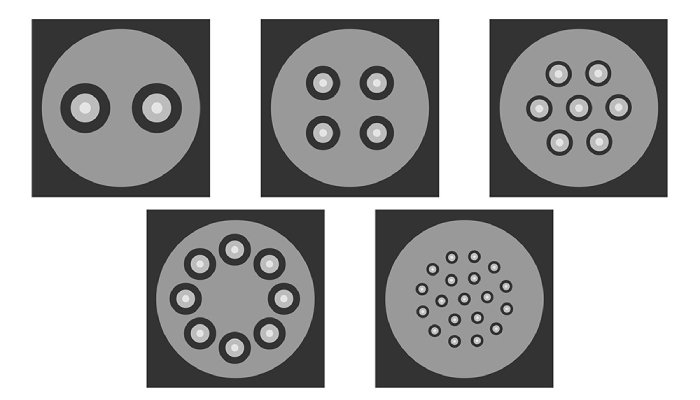With the rapid development of artificial intelligence (AI) technology, the demand for data processing and communication capacity has reached an unprecedented scale. Especially in fields such as big data analysis, deep learning, and cloud computing, communication systems have increasingly high requirements for high speed and high bandwidth. Traditional single-mode fiber (SMF) is affected by the nonlinear Shannon limit, and its transmission capacity will reach its upper limit. Spatial Division Multiplexing (SDM) transmission technology, represented by multi-core fiber (MCF), has been widely used in long-distance coherent transmission networks and short-range optical access networks, significantly improving the overall transmission capacity of the network.
Multi core optical fibers break through the limitations of traditional single-mode fibers by integrating multiple independent fiber cores into a single fiber, significantly increasing transmission capacity. A typical multi-core fiber may contain four to eight single-mode fiber cores evenly distributed in a protective sheath with a diameter of approximately 125um, significantly enhancing the overall bandwidth capability without increasing the outer diameter, providing an ideal solution to meet the explosive growth of communication demands in artificial intelligence.

The application of multi-core optical fibers requires solving a series of problems such as multi-core fiber connection and the connection between multi-core fibers and traditional fibers. It is necessary to develop peripheral related component products such as MCF fiber connectors, fan in and fan out devices for MCF-SCF conversion, and consider compatibility and universality with existing and commercial technologies.
Multi core fiber fan in/fan out device
How to connect multi-core optical fibers with traditional single core optical fibers? Multi core fiber fan in and fan out (FIFO) devices are key components for achieving efficient coupling between multi-core fibers and standard single-mode fibers. At present, there are several technologies for implementing multi-core fiber fan in and fan out devices: fused tapered technology, bundle fiber bundle method, 3D waveguide technology, and space optics technology. The above methods all have their own advantages and are suitable for different application scenarios.
Multi core fiber MCF fiber optic connector
The connection problem between multi-core optical fibers and single core optical fibers has been solved, but the connection between multi-core optical fibers still needs to be resolved. At present, multi-core optical fibers are mostly connected by fusion splicing, but this method also has certain limitations, such as high construction difficulty and difficult maintenance in the later stage. At present, there is no unified standard for the production of multi-core optical fibers. Each manufacturer produces multi-core optical fibers with different core arrangements, core sizes, core spacing, etc., which invisibly increases the difficulty of fusion splicing between multi-core optical fibers.
Multi core fiber MCF Hybrid module (applied to EDFA optical amplifier system)
In the Space Division Multiplexing (SDM) optical transmission system, the key to achieving high-capacity, high-speed, and long-distance transmission lies in compensating for the transmission loss of signals in optical fibers, and optical amplifiers are essential core components in this process. As an important driving force for the practical application of SDM technology, the performance of SDM fiber amplifiers directly determines the feasibility of the entire system. Among them, multi-core erbium-doped fiber amplifier (MC-EFA) has become an indispensable key component in SDM transmission systems.
A typical EDFA system is mainly composed of core components such as erbium-doped fiber (EDF), pump light source, coupler, isolator, and optical filter. In MC-EFA systems, in order to achieve efficient conversion between multi-core fiber (MCF) and single core fiber (SCF), the system usually introduces Fan in/Fan out (FIFO) devices. The future multi-core fiber EDFA solution is expected to directly integrate MCF-SCF conversion function into related optical components (such as 980/1550 WDM, gain flattening filter GFF), thereby simplifying the system architecture and improving overall performance.
With the continuous development of SDM technology, MCF Hybrid components will provide more efficient and low loss amplifier solutions for future high-capacity optical communication systems.
In this context, HYC has developed MCF fiber optic connectors specifically designed for multi-core fiber optic connections, with three interface types: LC type, FC type, and MC type. The LC type and FC type MCF multi-core fiber optic connectors have been partially modified and designed based on traditional LC/FC connectors, optimizing the positioning and retention function, improving the grinding coupling process, ensuring minimal changes in insertion loss after multiple couplings, and directly replacing expensive fusion splicing processes to ensure convenience of use. In addition, Yiyuantong has also designed a dedicated MC connector, which has a smaller size than traditional interface type connectors and can be applied to more dense spaces.
Post time: Jun-05-2025

